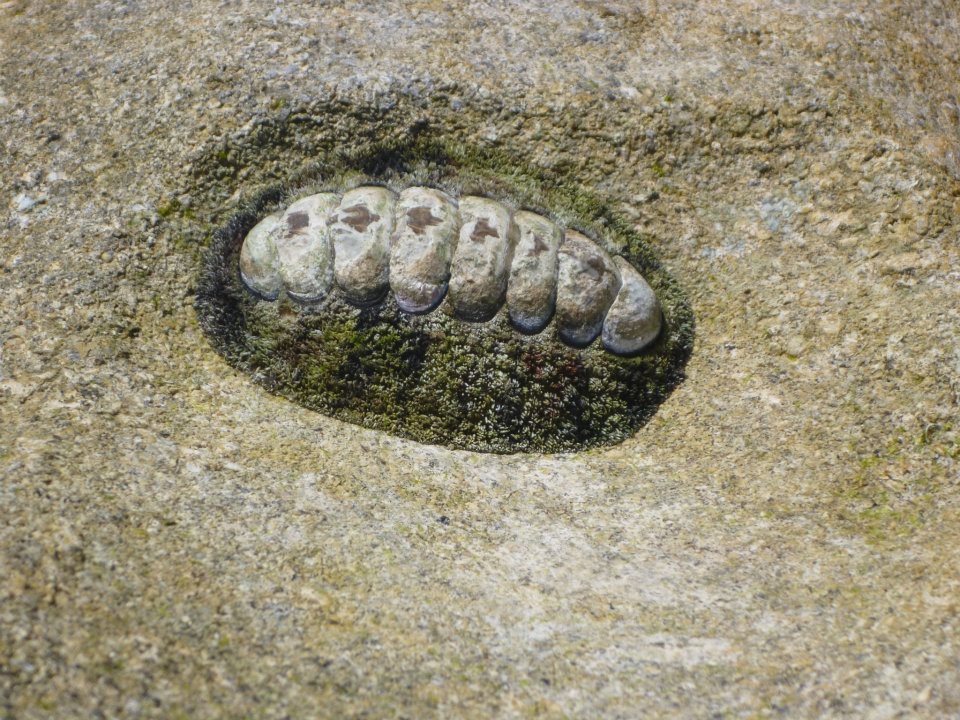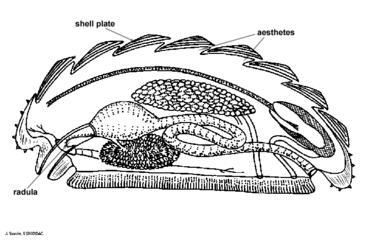External Morphology
Chitons are slow-moving, bilaterally symmetrical, marine molluscs.(1,2,3) They are all dorso-ventrally flattened and oval to elongate shape (Figure 1).(3,10) The most distinctive part of any chiton is its shell, which consists of a series of overlapping and articulating plates (usually 8) which cover the surface of the shell (Figure 1).(3,10) The plates are largely embedded in the mantle tissue (Polyplacophora actually means bearer of plates).(3,10) This mantle tissue is what secretes- or makes the hard shell.(3,10) Because of this unique, multi-sectioned shell, the body can is very flexible and can bend and attach to a variety of substrate shapes.(3,10) Each valve consists of four layers; tegmentum, articulamentum, periostracum and hypostracum.(3) The outermost layer is the periostracum.(3) Underneath the periostracum is the tegmentum (this layer contains the aesthetes) and underneath this layer is the purely calcareous articulamentum.(3) The hypostracum is the bottom layer and is also calcareous.(3)

Figure 1. A dorsal and ventral view of a chiton
Picture provided by: http://yhsbiology.wikispaces.com/Chiton
The shell is also unique in that is contains ‘eyes’.(3,10) Each plate or valve, contains unique microscopic structures called aesthetes which are light receptors (3,10), so chitons actually have eyes on their back!
A chiton has a thick lateral mantle which is also known as the girdle (Figure 1).(3,10) Most species the girdle has numerous calcareous spicules that are secreted independently of the shell plates (Figure 1).(10)A. gemmata is unique in that is has short spicules and a brown girdle with light bands (Figure 2). (8,12,13,16)

Figure 2. Acantheopleura gemmata
The ventral side of the chiton consists of a strong muscular foot that extends along the animal’s entire ventral surface (Figure 1).(10) The shell and girdle completely overly the foot and the head (but the head is very under-developed).(10) The head is under-developed and simple in chitons and the mouth is located at the anterior end.(3,10) The anus is at the opposite end of the body to the mouth, which indicates the animal has a linear digestive tract.(3,)
The radula (Figure 3) is well-developed in chitons to scrape food from the substratum.(3,10) The radula has a relatively uniform construction and consists of many transverse rows of 17 teeth each.(3) Many of the teeth are simple flat plates and as they develop they move forward and replace the anterior teeth as they are worn away. This forward progression of teeth enables the radula to length anteriorly and grow continuously throughout the animals life.(3)

Figure 3. An example of a radula
Chitons respire via gills. The gills are cone-shaped and are present within the mantle cavity (the mantle cavity takes the form of 2 lateral grooves in chitons, one on each side of the body).(3) Up to 80 bipectinate gills hang down from the roof of each groove and divide the mantle cavity into a inhalent and exhalent chamber.(3) Gill cilia draw water into the incurrent chamber and the water flows anterior to posterior so waste products are discharged posteriorly in the excurrent stream.(10) The direction of water flows oppositely to the flow of blood in the individual gill lamellae and forms a counter current exchange system that facilitates gas exchange.(10) |